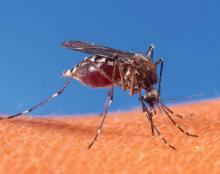VAIL, COLO. – Dengue fever and chikungunya have much in common in terms of symptoms, incubation period, clinical course, vector, and geographical distribution.
There is, however, a good way to distinguish the two tropical fevers based upon presenting symptoms: Dengue plus arthritis equals chikungunya, Dr. Jay S. Keystone said at a conference on pediatric infectious diseases sponsored by Children’s Hospital Colorado.
For fever in a traveler returned from Southeast Asia, the Caribbean, or Latin America, think "dengue" after first ruling out malaria. Studies show that dengue is in fact the most common cause of fever in returned travelers from those areas. There is not so much malaria in those parts of the world, in contrast to sub-Saharan Africa, where malaria accounts for nearly two-thirds of febrile illnesses in returned travelers, noted Dr. Keystone, professor of medicine at the University of Toronto and a past president of the International Society of Travel Medicine.
Both dengue and chikungunya are viral diseases whose vector is the Aedes aegypti mosquito. Chikungunya has as an additional vector, the Asian tiger mosquito (Aedes albopictus). Chikungunya is a problem in Southeast Asia, as is dengue, but also in India and sub-Saharan Africa.
A key feature shared by both diseases is that the fever comes on sharply about a week after exposure and lasts about a week before resolving. Dengue fever classically is accompanied by a headache, retro-orbital pain, prominent muscle aches, and adenopathy. Similarly, chikungunya features prominent headache and adenopathy, but instead of the myalgia that is so characteristic of dengue, chikungunya entails marked joint pain and arthritis.
"Joint pain is the difference between the two. In adults, the arthritis can go on for many months," according to Dr. Keystone.
A maculopapular rash is common beginning on about day 3 in patients with chikungunya, especially so in children.
Diagnosis of dengue fever is made serologically on the basis of the detection of antibodies to dengue virus. Chikungunya, too, is diagnosed serologically.
Treatment of both tropical fevers is symptomatic. However, NSAIDs are to be avoided because of capillary fragility and increased bleeding risk.
Dengue and chikungunya share one more thing: Medical epidemiologists and entomologists are worried that both diseases may be on the march. The North American habitat of A. aegypti extends north as far as Chicago, and last year a first-ever outbreak of 28 cases of dengue fever was reported in the Florida Keys. Similarly, a substantial outbreak of chikungunya occurred several years ago in Italy, probably as a result of the chikungunya virus spreading through the local Asian tiger mosquito population via exposure to an infected returned traveler.
Dr. Keystone declared having no relevant financial disclosures.



